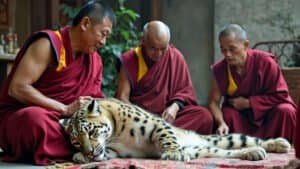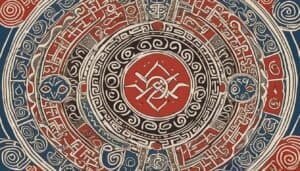Introduction
In Kazakh folklore, the snow leopard holds a position of deep cultural and symbolic importance. Revered as a creature of immense strength and beauty, the snow leopard appears in many traditional tales and myths, often symbolizing power, resilience, and a spiritual connection to the natural world
This article explores how the snow leopard is depicted in Kazakh folklore, its symbolic meaning within the culture, its role in rituals and ceremonies, and how modern Kazakhstan continues to honor this majestic animal through conservation and cultural preservation efforts
Cultural Depictions of Snow Leopards in Kazakh Folklore
Snow leopards have been an integral part of Kazakh folklore for centuries, embodying both the untamed spirit of the mountains and the strength of the nomadic peoples of Central Asia
In Kazakh tradition, these elusive big cats are often portrayed as protectors, symbols of power, and mystical creatures with a deep connection to the natural and spiritual worlds
They are revered for their independence, agility, and ability to survive in the harsh mountainous regions where many Kazakh tribes lived. These qualities made the snow leopard a fitting symbol for Kazakh warriors and leaders, who admired the animal’s prowess and resilience
Snow Leopards in Traditional Kazakh Tales
In Kazakh storytelling, snow leopards frequently appear in epic poems and folk stories passed down orally through generations
One of the central themes in these tales is the snow leopard’s role as a guardian of the land, protecting the mountains from evil spirits or intruders. For example, in some legends, a snow leopard is said to guide or protect lost travelers through dangerous terrains, using its keen instincts and knowledge of the mountains
These stories often depict the snow leopard as a wise, almost supernatural figure that can communicate with the natural elements, further reinforcing its spiritual significance
In other stories, the snow leopard may be a companion or symbolic animal for Kazakh heroes or warriors. These tales emphasize the connection between the snow leopard’s strength and the bravery of those who align themselves with the animal, suggesting that the snow leopard’s characteristics are aspirational for those living in the harsh environment of the steppes and mountains
Symbolic Attributes in Kazakh Stories
Symbolism in Kazakh folklore often centers on the snow leopard’s traits, which are seen as metaphors for survival and power. The animal’s stealth and ability to move through the mountains without being seen became symbolic of strategic prowess in battle and leadership
As a solitary and independent creature, the snow leopard is also associated with wisdom and self-reliance, qualities highly valued in Kazakh culture, where nomadic survival often depended on individual skill and resourcefulness
The snow leopard’s coat, marked with rosettes and gray fur that blends into the mountain rocks, is sometimes described in folklore as a “cloak of invisibility” that allows it to become one with its surroundings
This invisibility is symbolic of a deeper spiritual connection to the earth, an important concept in Kazakh shamanistic traditions where animals were believed to possess otherworldly powers
Snow Leopards and Kazakh Nomadic Lifestyle
Kazakh nomads, who lived in close harmony with nature, saw the snow leopard as a reflection of their own lives, which were dependent on the land and their ability to navigate its challenges
The snow leopard, like the nomads, thrives in an environment where adaptability is key. As such, the animal was often admired for its endurance and strength in harsh climates, representing the nomads’ ability to endure the difficult conditions of their lifestyle
In ancient times, the presence of snow leopards in certain areas was also believed to be a sign of a healthy ecosystem, symbolizing the balance between human and natural life
Because of their elusive nature, sightings of snow leopards were rare, and when a snow leopard was seen, it was often considered an omen of good fortune or a sign that the gods were watching over the land
Symbolism of Snow Leopards in Kazakh Culture
In Kazakh culture, snow leopards hold a deep symbolic meaning that transcends their physical presence in the mountainous regions. They are seen as powerful emblems of strength, resilience, and spiritual guidance
The nomadic tribes of Kazakhstan, who relied on their understanding of the natural world for survival, viewed the snow leopard as a spiritual being that embodied the harsh yet beautiful landscape in which they lived
Its elusive nature and mastery of its rugged environment resonated with the Kazakh people’s values of independence, strength, and wisdom
Representations of Strength and Power
The snow leopard is often associated with strength and power in Kazakh culture, representing the qualities of leadership and bravery. Just as the snow leopard dominates its harsh, mountainous habitat, Kazakh leaders were expected to demonstrate dominance and control over their people and environment
The snow leopard’s ability to survive and thrive in extreme conditions was seen as a reflection of the qualities needed by Kazakh warriors and leaders: courage, resilience, and adaptability
In traditional Kazakh imagery, the snow leopard is sometimes depicted alongside other animals that symbolize power, such as the eagle, further emphasizing its role as a symbol of authority
Historical records suggest that snow leopards were considered spirit animals for some tribal leaders, with their likenesses appearing on banners, clothing, and armor as a sign of strength and protection in battle. This association extended into the political realm as well, where the image of the snow leopard became tied to notions of kingship and rulership
Spiritual Meaning of Snow Leopards
Beyond physical power, the snow leopard also holds significant spiritual meaning in Kazakh culture. Many Kazakh tribes practiced forms of shamanism, where animals were believed to have spiritual powers that could influence the physical world
Snow leopards, in particular, were thought to be able to move between the physical and spiritual realms due to their elusive nature and their ability to navigate treacherous mountain landscapes. As a result, they were often seen as messengers or intermediaries between the human world and the spirit world
This spiritual connection is reflected in Kazakh folklore, where snow leopards are often depicted as guardians of sacred places, particularly in the mountains, which were considered the domain of the gods. In some stories, the snow leopard is a guide that leads humans through dangerous or unfamiliar terrain, helping them to find their way physically and spiritually
The idea of the snow leopard as a spiritual guide is also tied to its role in shamanic rituals, where it was believed that invoking the spirit of the snow leopard could bring protection or clarity
Connection to Kazakh Mythology
In Kazakh mythology, the snow leopard is often linked to the sky and the gods. Some legends suggest that the snow leopard was created by Tengri, the sky god, to rule over the mountains and watch over the people who lived there
This divine connection elevated the status of the snow leopard from mere animal to a celestial being with a sacred role in protecting both the land and its inhabitants
One famous Kazakh myth tells the story of a snow leopard who descends from the mountains to help a group of nomads who are lost in a snowstorm. The snow leopard guides them to safety and, in doing so, earns a place in their hearts as a symbol of divine intervention
In this way, the snow leopard became not only a protector but also a symbol of hope and survival, deeply ingrained in the mythology of the region
The snow leopard’s role in mythology also extends to its symbolism in dreams. Some Kazakh tribes believed that dreaming of a snow leopard was a sign of impending change or a call to embrace new challenges
This idea, rooted in the animal’s ability to navigate harsh environments, made it a powerful symbol of transformation and personal growth in Kazakh spiritual practices
Rituals and Ceremonies Involving Snow Leopards
Snow leopards have not only been revered in stories and symbolism but have also played a significant role in Kazakh rituals and ceremonies
Their majestic presence and connection to power, spirituality, and survival have made them integral to various traditional practices, especially those associated with warriors and important life events
These rituals reflect the snow leopard’s deep influence on the cultural identity of the Kazakh people, linking them closely with nature and the spiritual realm
Snow Leopards in Kazakh Warrior Traditions
One of the most significant roles of the snow leopard in Kazakh culture is its connection to warrior traditions. Kazakh warriors, known as batyrs, often took inspiration from the snow leopard’s stealth, strength, and ability to dominate its territory
It was common for warriors to invoke the spirit of the snow leopard before going into battle, seeking its guidance and power. The snow leopard symbolized both physical prowess and strategic cunning, qualities essential for success in warfare
In some warrior ceremonies, snow leopard skins were used as a form of protection, draped over armor or carried into battle as a totem of strength. These skins were not taken lightly; hunting a snow leopard was considered a highly dangerous and sacred act, performed only by the most skilled hunters
The snow leopard’s skin was believed to carry the animal’s spirit, conferring invincibility and bravery upon the warrior wearing it. For this reason, snow leopard skins became a prized possession, often reserved for tribal leaders or great warriors
Use of Snow Leopard Imagery in Kazakh Rituals
Beyond warfare, snow leopard imagery has appeared in other important Kazakh rituals. For example, in rites of passage, particularly those involving the transition from childhood to adulthood, young men were sometimes symbolically connected to the snow leopard to mark their new status as independent and capable individuals
This association emphasized qualities such as strength, courage, and the ability to navigate life’s challenges—qualities embodied by the snow leopard
The image of the snow leopard also played a role in marriage ceremonies, where it symbolized protection and strength for the new couple. Snow leopard motifs were often woven into wedding garments or incorporated into the decorations of the yurt, the traditional Kazakh dwelling, symbolizing a strong and prosperous union
The snow leopard’s ability to survive in the harshest of environments made it a fitting symbol for a couple embarking on the often difficult journey of married life
Modern Ceremonial Uses of Snow Leopard Symbols
In modern Kazakhstan, the cultural significance of the snow leopard remains strong, and its image continues to be used in various ceremonial contexts, though with a more symbolic and less practical approach than in ancient times
For example, the snow leopard is often featured in the celebrations of national identity, especially during public holidays that commemorate Kazakh history and cultural heritage. The snow leopard, as a national symbol, represents not only the natural beauty of the country’s rugged landscapes but also the strength and resilience of its people
In contemporary rituals, the snow leopard appears in the designs of traditional clothing worn during national holidays and festivals. Its image is also incorporated into performances of traditional Kazakh music and dance, where it represents the connection between the past and present, embodying the enduring spirit of the Kazakh people
The snow leopard’s iconic status was further solidified when it became a symbol of Kazakhstan’s efforts in wildlife conservation, serving as a reminder of the country’s responsibility to protect its natural heritage
Kazakh ceremonies today often blend ancient traditions with modern symbols of national pride, and the snow leopard remains central to this cultural tapestry
Its presence in contemporary rituals serves as a bridge between the ancient beliefs of the nomadic past and the current efforts to preserve both cultural and environmental heritage, making the snow leopard a timeless figure in Kazakhstan’s national consciousness
Snow Leopards in Modern Kazakh Culture
In modern Kazakhstan, the snow leopard remains a powerful cultural and national symbol, representing not only the natural beauty and resilience of the country but also its historical roots and connection to the nomadic past
As Kazakhstan has evolved, so too has the role of the snow leopard in its cultural narrative, shifting from myth and legend to a prominent symbol of national identity and environmental consciousness
This enduring reverence for the snow leopard reflects the deep bond between the Kazakh people and their natural surroundings, as well as a commitment to preserving the animal for future generations
Snow Leopards as National Symbols
Since Kazakhstan’s independence in 1991, the snow leopard has become an important national symbol, representing the country’s strength, independence, and connection to its heritage
The snow leopard’s image is prominently featured in Kazakhstan’s state emblem, where it is depicted alongside a shanyrak (the top of a traditional yurt), symbolizing unity, family, and the protection of the nation. This emblem serves as a reminder of Kazakhstan’s nomadic past and the values of courage, resilience, and wisdom that the snow leopard has come to represent
The snow leopard’s symbolic role extends beyond just the emblem. It is also used in various state-sponsored initiatives to promote national pride and unity
For example, snow leopards are frequently featured in educational materials, national holidays, and public art projects, where they represent both the natural beauty of Kazakhstan’s landscapes and the country’s efforts to protect its wildlife. In this way, the snow leopard has become a cultural ambassador for Kazakhstan, embodying its unique identity on the global stage
Conservation Efforts and Cultural Preservation
The modern significance of the snow leopard in Kazakh culture is closely tied to conservation efforts aimed at preserving this endangered species. Kazakhstan is home to some of the snow leopard’s critical habitats, particularly in the Almaty region and the Altai Mountains
Recognizing the importance of protecting these majestic animals, the government has launched several conservation programs to safeguard snow leopards and their habitats, working in collaboration with international organizations such as the Snow Leopard Trust and WWF (World Wildlife Fund)
The snow leopard’s endangered status has added a sense of urgency to these conservation efforts, elevating the animal from a cultural symbol to a rallying point for environmental activism. By protecting the snow leopard, Kazakhstan also aims to preserve its natural ecosystems, which are vital to maintaining the country’s biodiversity
Many modern Kazakh citizens see the survival of the snow leopard as a reflection of the nation’s ability to balance economic development with environmental stewardship, further strengthening the animal’s role in shaping Kazakhstan’s identity
Snow Leopard in Kazakh Art and Literature
Kazakh artists, writers, and poets continue to draw inspiration from the snow leopard, using its image and symbolism to explore themes of freedom, resilience, and the relationship between humans and nature
In contemporary Kazakh art, snow leopards are often depicted in vibrant paintings, sculptures, and public installations that reflect the animal’s importance in both the natural world and the cultural consciousness of Kazakhstan
In literature, the snow leopard is frequently used as a metaphor for the Kazakh spirit—strong, independent, and unyielding in the face of adversity
Modern Kazakh poets and writers often weave references to the snow leopard into their works, using the animal as a symbol of the nation’s enduring connection to its nomadic roots and the harsh yet beautiful landscapes of Central Asia. This blending of ancient symbolism with modern storytelling helps keep the snow leopard relevant in the contemporary cultural narrative
As Kazakhstan continues to grow and modernize, the snow leopard remains a powerful emblem of the country’s past, present, and future
Through art, literature, and conservation efforts, the snow leopard continues to inspire Kazakh citizens and remind them of their responsibility to protect both their cultural heritage and the natural world
Conclusion
Throughout Kazakh history and folklore, the snow leopard has maintained a position of deep cultural significance. It is revered not only as a symbol of strength, resilience, and spiritual guidance but also as a powerful emblem of Kazakhstan’s national identity
Whether in traditional stories that highlight the snow leopard’s connection to Kazakh warriors, or in modern conservation efforts that emphasize the importance of preserving this majestic species, the snow leopard’s influence is woven into the fabric of Kazakh culture
As Kazakhstan continues to modernize, the snow leopard serves as a bridge between the past and present, embodying both the nation’s nomadic heritage and its commitment to protecting the natural world for future generations










